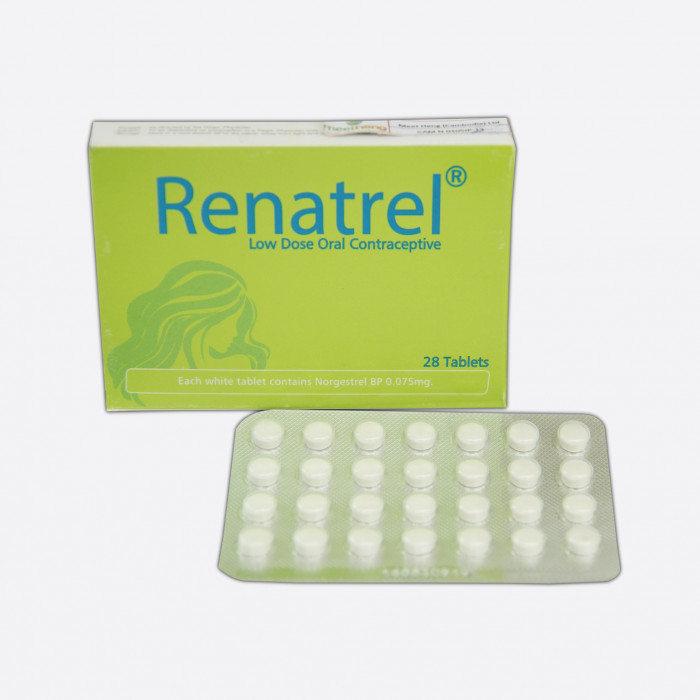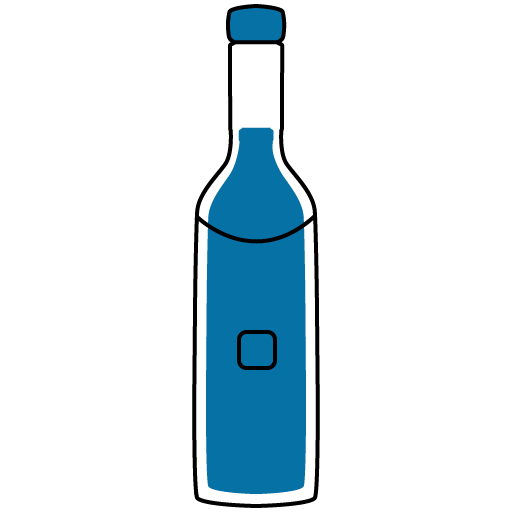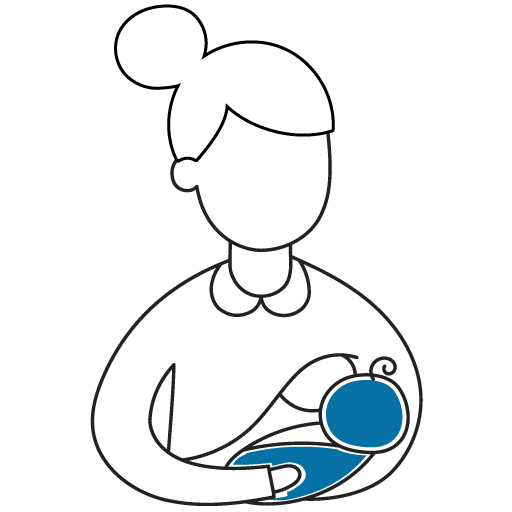
✔ 100% Authentic Product
👁️ Currently Viewing 2220
Renatrel, particularly its active stereoisomer levonorgestrel, operates by binding to progesterone and estrogen receptors located in various parts of the female reproductive system, including the reproductive tract, mammary gland, hypothalamus, and pituitary gland. Upon binding to these receptors, progestins like levonorgestrel decrease the frequency of gonadotropin-releasing hormone (GnRH) release from the hypothalamus and dampen the pre-ovulatory surge of luteinizing hormone (LH). The suppression of the LH surge effectively inhibits ovulation, thereby preventing pregnancy.
Discount
Price: ৳ 39
MRP:
৳
42
6%
Off

100% Genuine Products, Guaranteed

Safe & Secure Payments, Always

Fast, Secure & Efficient Delivery

Proper Packaging
 Cash on Delivery - All over Bangladesh
Cash on Delivery - All over Bangladesh Regular Delivery - 12-24 Hours, Dhaka City* Charge Tk.39-59
Regular Delivery - 12-24 Hours, Dhaka City* Charge Tk.39-59 Regular Delivery - 24-48 Hours, Other Cities* Charge Tk.99-110
Regular Delivery - 24-48 Hours, Other Cities* Charge Tk.99-110
 ফ্রি ডেলিভারিঃ - ৯৯৯ টাকা+ অর্ডারে, ঢাকা
শহরে
ফ্রি ডেলিভারিঃ - ৯৯৯ টাকা+ অর্ডারে, ঢাকা
শহরে ফ্রি ডেলিভারিঃ - ২৯৯৯ টাকা+ অর্ডারে, ঢাকার
বাহিরে
ফ্রি ডেলিভারিঃ - ২৯৯৯ টাকা+ অর্ডারে, ঢাকার
বাহিরে
100% Genuine Products, Guaranteed
Safe & Secure Payments, Always
Fast, Secure & Efficient Delivery
Proper Packaging
 Cash on Delivery - All over Bangladesh
Cash on Delivery - All over Bangladesh Regular Delivery - 12-24 Hours, Dhaka City* Charge Tk.39-59
Regular Delivery - 12-24 Hours, Dhaka City* Charge Tk.39-59 Regular Delivery - 24-48 Hours, Other Cities* Charge Tk.99-110
Regular Delivery - 24-48 Hours, Other Cities* Charge Tk.99-110 ফ্রি ডেলিভারিঃ - ৯৯৯ টাকা+ অর্ডারে, ঢাকা
শহরে
ফ্রি ডেলিভারিঃ - ৯৯৯ টাকা+ অর্ডারে, ঢাকা
শহরে ফ্রি ডেলিভারিঃ - ২৯৯৯ টাকা+ অর্ডারে, ঢাকার
বাহিরে
ফ্রি ডেলিভারিঃ - ২৯৯৯ টাকা+ অর্ডারে, ঢাকার
বাহিরে
✅ Description:
Renatrel (and more specifically the active stereoisomer levonorgestrel) binds to the progesterone and estrogen receptors within the female reproductive tract, the mammary gland, the hypothalamus, and the pituitary. Once bound to the receptor, progestins like levonorgestrel will slow the frequency of release of gonadotropin-releasing hormone (GnRH) from the hypothalamus and blunt the pre-ovulatory LH (luteinizing hormone) surge. Loss of the LH surge inhibits ovulation and thereby prevents pregnancy.
Safety Advices

Alcohol
UNSAFE
It's recommended to avoid consuming alcohol while taking Renatrel to prevent potential adverse effects or interactions.

Pregnancy
CONSULT YOUR DOCTOR
Renatrel is considered unsafe during pregnancy

Breastfeeding
Caution should be exercised during breastfeeding. It's advisable to consult a doctor before using this medication in such situations.

Driving
CAUTION
Renatrel is unlikely to affect the ability to drive or operate machinery when prescribed. However, individual responses may vary, so it's essential to follow medical advice.

Kidney
There is insufficient information available regarding the use of Renatrel in patients with kidney dysfunction. Consulting a doctor is recommended in such cases to assess the suitability and safety of the medication.

Liver
CONSULT YOUR DOCTOR
There is insufficient information available regarding the use of Renatrel in patients with liver or kidney dysfunction.
✔️ Uses of Renatrel
- Contraception
- Menorrhagia
- Menopausal HRT
✔️ How does Renatrel work?
Norgestrel is a progestin (female hormones). It works to prevent pregnancy by temporarily stopping the release of an egg from the ovary, or preventing fertilization (union) of the egg by sperm. It may also alter the lining of the uterus (womb) to stop a fertilized egg from attaching to the uterus.
✔️ Side Effects of Renatrel
Edema, Weakness, Anorexia, Amenorrhea, Breakthrough bleeding, Change in menstrual flow, Spotting
✔️ Quick Tips:
- It's advised to keep your weight within a healthy range (BMI 19.5-24.9) through proper diet and regular exercise. Opt for a diet rich in whole grains, fruits, vegetables, and low-fat dairy products. Avoid smoking and limit alcohol consumption to reduce the risk of complications.
- Regular exercise is recommended to help maintain weight and overall health, especially considering potential weight fluctuations caused by Renatrel.
- It's essential to monitor blood pressure regularly, particularly if there are fluctuations. Any significant changes should be reported to your doctor promptly.
- Including heart-healthy omega-3 fatty acids in your diet and using low-fat cooking oils like olive oil, soybean oil, canola oil, and coconut oil may help lower elevated blood pressure. However, it's advised to consult with a healthcare professional for personalized dietary recommendations.
✔️ Indication of Renatrel
Renatrel, when combined with ethinyl estradiol, is primarily utilized for preventing pregnancy in women who choose this method of contraception. Additionally, Renatrel is employed in the treatment of various conditions, including:
- Abnormal Uterine Bleeding
- Endometriosis
- Hypermenorrhea
- Menstrual Distress (Dysmenorrhea)
- Polycystic Ovarian Syndrome
- Emergency Contraception
- Oral Contraceptives
✔️ Pharmacology
Progestin-only oral contraceptives, like Norgestrel tablets, work by several mechanisms to prevent conception:
Suppression of ovulation: Progestins inhibit the release of gonadotropin-releasing hormone (GnRH) from the hypothalamus, which in turn decreases the secretion of luteinizing hormone (LH) and follicle-stimulating hormone (FSH) from the pituitary gland. This suppression of LH and FSH prevents the maturation and release of an egg from the ovary, thus inhibiting ovulation.
Thickening of cervical mucus: Progestins thicken the cervical mucus, making it more difficult for sperm to penetrate into the uterus and reach the egg for fertilization.
Alteration of the endometrium: Progestins alter the lining of the uterus (endometrium), making it less favorable for implantation of a fertilized egg.
Lowering midcycle LH and FSH peaks: By reducing the levels of LH and FSH, progestins help to maintain a state of hormonal suppression, further inhibiting ovulation and pregnancy.
Slowing movement of the ovum: Progestins slow down the movement of the egg through the fallopian tubes, reducing the likelihood of fertilization by sperm.
After oral administration, serum levels of progestins peak about two hours later, followed by rapid distribution and elimination from the body. Within 24 hours after ingestion, serum levels return to near baseline, highlighting the importance of strict adherence to the dosing schedule for efficacy.
✔️ Dosage & Administration of Renatrel
Contraception Monotherapy:
- Adult: 30 or 37.5 mcg/day.
Monophasic Combined Oral Contraceptive (COC):
- Adult: 150-250 mcg/day.
Triphasic COC:
- Adult: 50-125 mcg/day.
Emergency Contraception:
- 1.5 mg within 72 hours of coitus, or
- 750 mcg immediately or within 72 hours of coitus, followed by a second dose of 750 mcg 12 hours later.
Menopausal Hormone Replacement Therapy (HRT) as a progestogenic component:
- Adult: 75-250 mcg/day for 10-12 days of a 28-day cycle.
✔️ Interaction
Food Interaction:
- Avoid grapefruit products and St. John's Wort
- Take Renatrel at the same time every day
- Grapefruit juice may increase plasma concentrations of drugs metabolized by CYP450 3A4
Alcohol Interaction:
- Ethanol levels and central nervous system effects may be increased, although data are lacking
Cholesterol Interaction:
- Some progestogenic agents may elevate plasma LDL levels, requiring closer monitoring in patients with preexisting hyperlipidemia
Hypertension Interaction:
- Estrogens and progestogens may cause fluid retention, requiring cautious use in patients with preexisting fluid-related conditions
Unknown Drug Interactions:
- Aripiprazole, chlorpheniramine, amoxicillin/clavulanate, citalopram, ciprofloxacin, venlafaxine, etc.
Disease Interactions:
- Major: Hepatic neoplasms, breast malignancy, thromboembolism
- Moderate: Depression, fluid retention, glucose intolerance, hyperlipidemia
- Minor: Weight gain
✔️ Contraindications
- Documented hypersensitivity
- Active or history of breast cancer
- Arterial thromboembolic disease, thrombophlebitis, deep vein thrombosis/pulmonary embolism, thrombogenic valvular disease
- Estrogen-dependent neoplasia
- Liver disease, liver tumors
- Undiagnosed abnormal vaginal bleeding
- Uncontrolled hypertension
- Diabetes mellitus with vascular involvement
- Jaundice with prior oral contraceptive use
- Pregnancy or use as a diagnostic test for pregnancy
✔️ Pregnancy & Lactation
Contraindicated in pregnancy (Category X) and considered unsafe during lactation
✔️ Precautions & Warnings
- Documented hypersensitivity
- History of breast cancer
- Thrombophlebitis, deep vein thrombosis/pulmonary embolism, thrombogenic valvular disease
- Estrogen-dependent neoplasia
- Liver disease, liver tumors
- Undiagnosed abnormal vaginal bleeding
- Uncontrolled hypertension
- Diabetes mellitus with vascular involvement
- History of migraine with aura
- Pregnancy, smoking more than 15 cigarettes per day, and over 35 years of age
- Serum levels should be near baseline 24 hours after ingestion, so adherence to the dosing schedule is crucial
- Conditions such as diabetes mellitus, asthma, cardiac dysfunction, irregular menstrual bleeding patterns, bone mineral density changes, depression, epilepsy, migraine, and renal dysfunction may require monitoring
✔️ Storage Conditions:
Store in a cool and dry place.
⚠️Disclaimer:
At ePharma, we’re committed to providing accurate and accessible health information. However, all content is intended for informational purposes only and should not replace medical advice from a qualified physician. Please consult your healthcare provider for personalized guidance. We aim to support, not substitute, the doctor-patient relationship.






